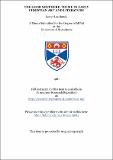Files in this item
The Good Shepherd theme in early Christian art and literature
Item metadata
| dc.contributor.advisor | Alexander, James | |
| dc.contributor.author | Bundy, Lester Lee | |
| dc.coverage.spatial | 173 p. | en_US |
| dc.date.accessioned | 2018-06-04T08:23:20Z | |
| dc.date.available | 2018-06-04T08:23:20Z | |
| dc.date.issued | 1981-07 | |
| dc.identifier.uri | https://hdl.handle.net/10023/13683 | |
| dc.description.abstract | This thesis is an exploration of the figure of the Good Shepherd in Patristic literature and early Christian art of the first four and one-half centuries. The study focuses on the question of unity and continuity within the imagery of this era and treats the general meaning of the symbolism associated with the Good Shepherd in both literature and art. The relationship of the literary figure to the visual arts figure is examined in regard to various themes in terms of chronological development. As the visual arts figure is largely taken from pagan imagery, the relationship of pagan, Jewish and early Christian imagery is explored. Early Christian art, primarily that of catacomb paintings and sarcophagi, is discussed briefly and a development of the figure which is progressively more mystical and expressionistic is shown. Patristic writing indicative of the "main-streams" of Christian thought is examined and again a development of the figure is noted. Patristic use of the Shepherd figure is shown to focus on the themes of the Shepherd as: Teacher, Redeemer, Judge, Unifier, and Christological illustration. The subsidiary themes of the bishops as the Shepherd's Successors and the people as the Shepherd's Flock are also discussed. It is shown that at the end of the fourth century and the beginning of the fifth, there is a decline in the use of Shepherd imagery to represent Christ in both literary and visual arts usage. Concomitantly there is an increasing tendency to portray Christ as a Royal figure and to portray the bishops as the Shepherds of God's Flock. This tendency coincides with christological developments within the thinking and teaching of the Church. Overall it can be seen that the usage of the literary and visual arts figure of the Good Shepherd is related to apologetic and catechetic activity within the Church. It can also be seen that the development of the literary and visual figure represents the growth and development of the Church's concept of the nature and work of Jesus Christ. The Good Shepherd is an ὲικών of the Heilsgeschichte of the first four and one-half centuries of Christianity. | en_US |
| dc.language.iso | en | en_US |
| dc.publisher | University of St Andrews | |
| dc.subject.lcc | BR55.G7B9 | en |
| dc.subject.lcsh | Art, Early Christian--Themes, motives | en |
| dc.subject.lcsh | Christian literature, Early | en |
| dc.title | The Good Shepherd theme in early Christian art and literature | en_US |
| dc.type | Thesis | en_US |
| dc.type.qualificationlevel | Masters | en_US |
| dc.type.qualificationname | MPhil Master of Philosophy | en_US |
| dc.publisher.institution | The University of St Andrews | en_US |
This item appears in the following Collection(s)
Items in the St Andrews Research Repository are protected by copyright, with all rights reserved, unless otherwise indicated.

